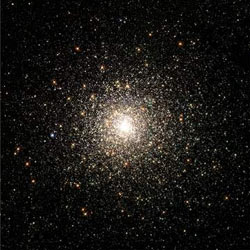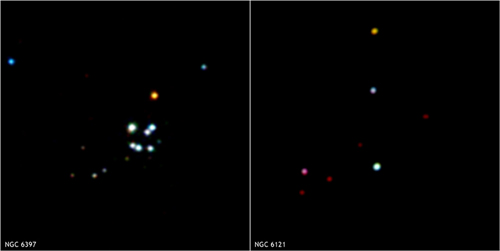 Globular clusters are one of those types of astronomical objects that make everyone happy: they are incredibly beautiful to observe, jaw-dropping even in small telescopes; and they are also tailor-made laboratories for studying stellar evolution, an environment where studying how stars age and interact is almost too easy.
Globular clusters are one of those types of astronomical objects that make everyone happy: they are incredibly beautiful to observe, jaw-dropping even in small telescopes; and they are also tailor-made laboratories for studying stellar evolution, an environment where studying how stars age and interact is almost too easy.
But that last bit has run into a problem of late. A wrinkle has turned up that makes examining globulars a bit more complicated than previously thought.
Globular clusters (or just GCs) are roughly spherical collections of hundreds of thousands or millions of stars held together by their own gravity. They look a bit like beehives, and in fact the individual stars orbit the center on mostly randomly distributed paths, so a time-lapse movie (lasting millions of years) of a GC would strongly remind you of bees around a hive.
Early on, astronomers noticed that GCs appeared to lack massive stars, and in fact when examined closely it was seen that all stars above a cutoff mass were gone. This implied that a GC forms all at once from a cloud of gas, with all the stars switching on simultaneously, or near enough. A star’s lifetime is dependent on its mass, and more massive stars live shorter lives. Some high-mass stars explode after 10 million years, some after 100 million. A GC older than that will therefore not have those kinds of stars in it. They’ll all have died.
The Sun will turn into a red giant when it’s about 12 billion years old. So if you don’t see any Sun-like stars in a GC, you know it must be older than that age. By observing the kind of stars in a GC, we can get an idea of its age! In fact, this caused a problem some years ago: the oldest GCs looked to be older than the Universe itself! It turns out this was due to astronomers not knowing the age of the Universe very well, and as time went on we figured out that the Universe was older than first thought (it’s 13.73 billion years old now) and the paradox was resolved.
Anyway, over time, the stars inside a GC orbit around, and because they are so tightly packed together, encounters between two stars are common. They pass close enough to gravitationally affect each other, changing their orbits. In general, if two stars of different mass pass each other, the lower mass star will gain energy, boosting it to a larger orbit, and the higher mass star will lose energy, dropping it to the center of the cluster. Over time, you get “mass segregation”, with the hefty stars all in the center and the lighter-weight ones relegated to the cluster’s suburbs.
Not only that, but the stars near the center can actually interact and become bound to each other, forming binary stars. That takes time, though, billions of years. First the stars have to fall to the center, and then they need time to interact. So another way to get the age of a GC is by looking at the binaries in the core. This is called the dynamical age of the GC – how long stars have been interacting with one another – as opposed to the actual ages of the stars in it.
Binaries in the core reveal themselves through X-rays. High mass stars explode and leave behind neutron stars or black holes. If one of these is orbiting a normal star, then it can siphon off gas from the star and gobble it down, which produces a lot of X-rays (see here for details). So detecting these binaries is not terribly hard: point your X-ray telescope at a GC and count up the sources of X-rays in the middle.
Astronomers did this recently using the Chandra X-Ray Observatory. And there’s the problem: in several GCs, they found too many X-ray binaries.
 |
| Chandra image of two GCs: NGC 6397 (left) and NGC 6121 (right); 6397 is old, but it has far more binaries than expected, making it look younger. |
When the GC is young, you don’t expect to see too many binaries in the core. When it’s middle aged, you see quite a few as the stars in the center interact, and then when it’s old the number tapers off again (as the normal stars die off and the source of X-rays shuts off). What the astronomers found is that in some clusters that were presumed to be really old (due to the age determined by looking at the stars in them), there were still more binaries than expected, as if they were younger.
Why? Well, all this also depends on how dense the cores of the GCs are. A less dense core should have fewer encounters between stars, and therefore fewer binaries. But one older GC which was expected to only have a few binaries had quite a few more than predicted. In other words, the stars themselves in that GC are old, but the core appears to be somewhat more immature.
What this means is that age is not the only thing that drives the number of binaries in the core, and that they are not the simple laboratories that has always been assumed. Most likely, this doesn’t affect things too much; they can still be used to study how stars age and interact, but you have to be more careful when poking around in the details. As usual, the Universe is a wee bit more complex than we usually assume. But the beauty of it, too, is that this complexity can be revealed, and we can revise our ideas to accommodate it.
So obviously, you have to be careful when dating heavenly bodies. They might look older on the outside, but be younger and less mature on the inside.
If there’s a life lesson in there, you’re welcome to determine it your own self.